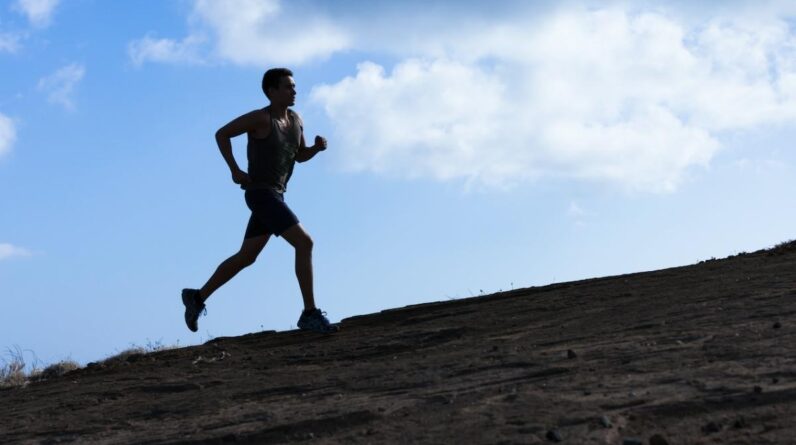
I grew up in the late ’70s and ’80s, have been an athlete my entire life, and have loved football for as far back as I can remember. So one of my favorite training stories from the mainstream media as a kid was the hill that legendary running back Walter Payton used to condition himself in the off-season. Look anywhere on the internet and you can find stories of Payton’s out-of-this-world conditioning, how he would bring athletes from all sports to train with him, and how they would all ultimately tap out from exhaustion. He’s one of the NFL’s most prolific runners, arguably one of the greatest of all time, and the hill was his secret.
I’ve been coaching for almost twenty years now, and I am obsessed with hill running. I have Payton to thank for this, and since speed is the ultimate goal in all of my programs, hills (or stairs for those of you who don’t have a suitable hill close by) are an absolute must in any speed or conditioning program. I’ve spent the bulk of my career split between Cal Poly and San Jose State and both places have significant hill/stadium inclines that are perfect for hammering my athletes.
Why Hills?
Strength and power are critical when we are talking speed, especially during the acceleration phase. Forty-yard dashes, great running backs darting through a seam, a batter racing down the first base line trying to beat out a throw, or a forward exploding to the hole, the sudden burst of speed is the most important factor. It’s the first three to five steps that determine the success of the effort.
Watch the NFL combine. When you see the athletes run their 40s, it’s the start that is the greatest determiner of a good time. Inversely, when you see a guy stumble out of the gate or take a sloppy step, you can rest assured that the time will be less than impressive.
Hill running teaches the drive phase of a sprint as nothing else can. Because of the incline, the runner must use the forefoot to climb. One of the most important speed training cues we use is that front of the foot is for speed, the heels are for braking. Even big guys, who by virtue of their size and propensity to heel contact first when they run on flat ground, are forced into an “appropriate” sprinting position. Think of the lean that you see world-class sprinters use in the first 50-70 meters of a 100-meter dash — that is the position we want to teach and the hill automatically does it for us.
The most obvious benefit is the load hill running puts on the legs. I have always thought that parachute pulling, banded running, and partner towing are silly given that all of those devices or routines are targeting the benefits of time on the hills. Next to squatting, Olympic lifting and/or kettlebell training, nothing will address leg strength and explosiveness like sprints up a hill.
Use Hills for Lateral Applications
Because the vast majority of the teams that I train for speed don’t actually get opportunities in their sports to run straight ahead where track workouts would benefit them (think top-end speed), we devote nearly all of our time working change of direction training. Many kids have little or no understanding of how to turn. They have no understanding of where their body is in space, insist on using their toes to slow down, and more often than not, have little control of their momentum when they run.
Because of the incline of your chosen hill, the runner must naturally situate his/her drive foot in a “toe-in” position when they laterally climb. If they don’t, their efficiency goes down the toilet and they will feel, almost instinctively, a need to adjust. When one are on flat ground, one of the major takeaways in footing that I teach is a subtle toe-in on the outside leg of a directional turn. This does two things. First, it allows the runner to access the big toe completely when they drive. Second, it directionally is in sync with where they are trying to go. Believe it or not, this is something that many of these kids do not possess when they show up at first. And, what you get when they don’t own this technique is a slow, power-stripped attempt at redirecting themselves.
Next, gravity is a bully. The natural incline of the hill demands a very forceful push. One that is necessary on flat ground when the athlete is attempting to accelerate. If I can get a kid to haul ass up the hill, either laterally or straight ahead, they have context and I can get that type of understanding on flat ground.
The Benefits of Backward Hill Sprints
Hill running backward is the perfect way to hammer your athletes. The hill I use is out behind our sports complex at Cal Poly is about a 35-yard climb at approximately a 14 percent grade. Steep. We have integrated backward running into the final phase of our hill workouts. Part of it is because I want my kids considerably uncomfortable, part of functional speed for my defensive backs and linebackers, and the other part is because I want them to develop a degree of toughness.
When I was in college, we used to have to backpedal around the outside of the Begley Building at EKU. Truthfully, it was a by-design way to make us miserable. The changes in incline outside were constant and there was an intimate relationship with misery because we would be told to do this for 15 minutes or more without stopping. It was a total jerk move but it taught us a lesson — learn how to push through pain. Nothing careless, just a leg burn that would make you nearly gag on your own vomit.
The foot drive that backward hill running produces basically cannot be duplicated anywhere else. It teaches the kids how to push with all they have off of the forefoot. Remember, acceleration happens at the front of the foot and braking happens in the heel. This trains the runner on the appropriate pressures, where to put them, and how to use their feet in an economic way.
Hills Teach Running Efficiency
Again, because of the incline, the runner is put into a position where they have no choice but to give an all-out effort. Because of the distance, they have to travel up a hill, casual jumping or sissified hopping only makes the getting up the hill take 10 times longer. Because they want it to be over as soon as possible, you get a natural full effort.
The bounding has turned out to be the hardest thing for my kids. Other things might hurt more, but the bounding makes them work as hard as they can, coordinate movements to be as efficient as possible, and it completely burns their anaerobic energy systems to the ground. It’s a pleasure to watch.
Featured Image: KieferPix/Shutterstock







